Isostasy | Geology Optional for UPSC PDF Download
| Table of contents |

|
| Isostasy |

|
| Development of the Isostasy Concept |

|
| Concept of Sir George Airy |

|
| Concept of Archdeacon Pratt |

|
| Concept of Hayford and Bowie |

|
| Concept of Jolly |

|
Isostasy
Definition and Origin
- Isostasy derives from the Greek word ‘iso-stasios’ meaning ‘equal standing’ and was first proposed by American geologist Clarence Dutton in 1889. It refers to the state of balance that exists between large upstanding areas of the Earth’s surface such as mountain ranges and plateaus.
Theory
- Isostasy theory posits that less dense materials of the Earth’s surface (sial) float over denser magma (sima) of the Earth’s interior. The Earth's interior comprises several concentric layers with the densest material forming the core and the lightest material forming the Earth’s surface. Each layer and Earth’s surface features rest on one another with an isostatic adjustment.
Application
- Isostasy is crucial in explaining phenomena such as glacial adjustment, as seen in Scandinavian countries post the Pleistocene ice age. For example, the raised beaches of Finland exhibit uplift of about 250 meters over the last 8000 years due to isostatic adjustment.
Development of the Isostasy Concept
Pierre Bouguer’s Contribution
- During his Andes expedition (1735-45), Pierre Bouguer observed that the towering volcanic peak of Chimborazo did not attract the plumb line as expected. This led him to suggest that the gravitational attraction of the Andes was much smaller than expected from their mass.
George Everest’s Observation
- During the geodetic survey of the Indo-Gangetic plain in 1859 under Sir George Everest, discrepancies were noted in latitude determination between Kalianpur and Kaliana, 370 miles apart. The difference was attributed to the less attractive force of the Himalayas, causing deflection of the plumb bob used in astronomical latitude determination.
Gravitational Attraction Theories
- Various theories exist to explain gravitational attraction and deflection, contributing to the understanding of isostatic balance among different landforms.
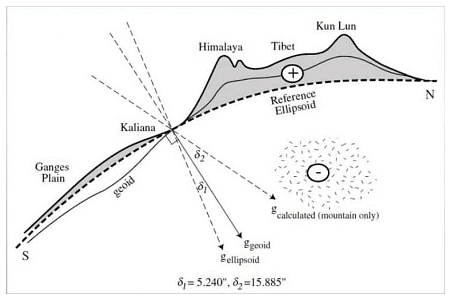
Concept of Sir George Airy
Theory of Floating Mountains
Sir George Airy proposed that the inner part of mountains cannot be hollow, but rather their excess weight is balanced by lighter materials below. According to him, the crust of relatively lighter material floats over denser material, with the Himalayas floating in denser glassy magma. Airy likened this to a boat floating in water, with the majority of its mass submerged.
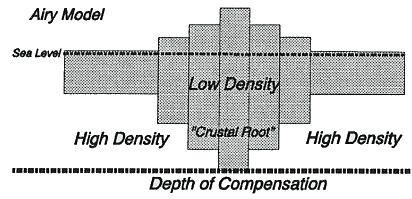
Principle of Floatation
Airy applied the principle of floatation to the Earth's crust, suggesting that for every part of the crust above the substratum, nine parts must be submerged below. Using this principle, Airy calculated that for the height of the Himalayas (8848 meters), there must be a downward projection of lighter material in the substratum reaching approximately 79,632 meters (if the freeboard to draught ratio is taken as 1 to 9).
Uniform Density Concept
Airy proposed that the density of different land columns remains the same, with density not changing with depth. This means that continents are made of rocks with uniform density but varying thickness. To illustrate this concept, Airy conducted experiments with iron and wood pieces of varying lengths, demonstrating how they sink to varying depths in a basin of mercury or water respectively.
Critique of Airy's Concept
While Airy's concept is respected, it faces criticism due to the impracticality of such long roots beneath mountains, as they would likely melt at the high temperatures found deep within the Earth's interior.

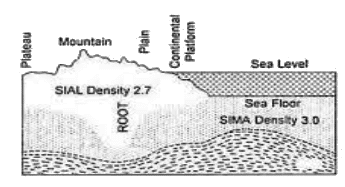
Concept of Archdeacon Pratt
Inverse Relationship Theory
- Archdeacon Pratt proposed an inverse relationship between the height of relief features and their respective densities. He observed that the density of each higher part is less than that of the lower part, suggesting that density decreases with increasing elevation.

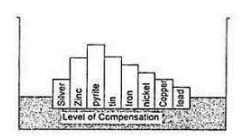
Uniform Depth with Varying
- DensityPratt's concept revolves around the idea of uniform depth with varying density, meaning that while density remains constant within a column, it changes from one column to another above a certain level. He emphasized that density varies only in the lithosphere and not in the pyrosphere and barysphere.
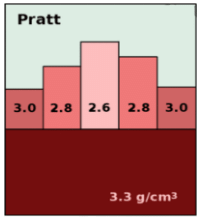
Principle of Compensation
- Pratt's theory is centered on the "law of compensation," asserting that equal surface area must underlie equal mass along the line of compensation. He explained this principle using the example of two columns with equal surface areas but different heights, where the denser column compensates for its height with greater density.
Comparison with Airy's Concept
- Bowie noted the fundamental difference between Airy's and Pratt's views, highlighting Airy's postulation of uniform density with varying thickness versus Pratt's proposition of uniform depth with varying density.
Concept of Hayford and Bowie
Plane of Compensation
Hayford and Bowie's concept of isostasy aligns closely with Pratt's, proposing a plane where there is complete compensation of crustal parts. Densities vary with the elevation of crustal columns above this plane, with mountains having lower density crust compared to ocean floors.
Inverse Relationship
Similar to Pratt, Hayford and Bowie suggest an inverse relationship between the height of crustal columns and their respective densities above the plane of compensation. Columns with lower density rocks stand higher than those with higher density rocks.
 Location of Compensation Plane
Location of Compensation Plane
The plane of compensation is estimated to be located at a depth of about 100 kilometers below the Earth's surface. Below this plane, there is a zone where density is uniform laterally.
Illustration and Explanation
Hayford and Bowie use an illustration of imaginary columns reaching the plane of compensation, with varying heights but balanced by their densities. This ensures equal downward pressure along the plane of compensation, balancing the columns.
Comparison with Airy and Pratt
Bowie notes similarities between Airy's and Pratt's concepts of isostasy but also identifies differences. While there are glimpses of Airy's concept of root formation and the law of floatation in Pratt's views, Hayford and Bowie's concept aligns more closely with Pratt's.
Concept of Jolly
Disapproval of Plane of Compensation
- Joly rejects the idea of a plane of compensation at a depth of about 100 kilometers due to concerns about high temperatures causing liquefaction, rendering such a level impossible.
Zone of Compensation
- Instead of a linear plane, Joly proposes a zone of compensation approximately 10 miles (16 kilometers) thick below a shell of uniform density. Within this zone, density varies, with areas of low density corresponding to downward projections of lighter continental crust and areas of high density representing heavier underlying material.
Comparison with Airy and Hayford/Bowie
- Joly's concept, while not explicitly mentioning the law of floatation, aligns more closely with Airy's concept than with the idea of a plane of compensation proposed by Hayford and Bowie. His concept suggests a zonal rather than linear phenomenon of compensation.
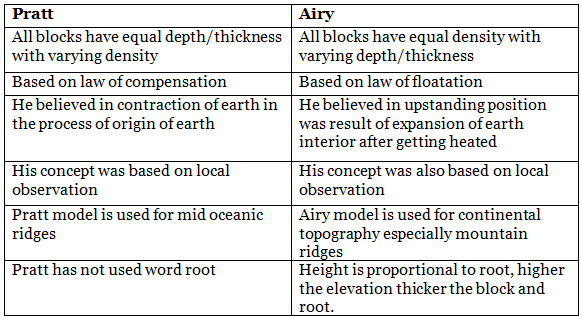
|
64 videos|135 docs
|
FAQs on Isostasy - Geology Optional for UPSC
| 1. What is the concept of isostasy? |  |
| 2. Who developed the concept of isostasy? |  |
| 3. How does isostasy affect the Earth's surface? |  |
| 4. What are some real-world examples of isostasy in action? |  |
| 5. How is the concept of isostasy relevant in the field of geology? |  |















